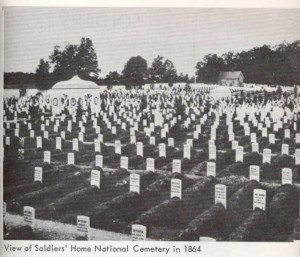In the aftermath of the First Battle of Bull Run, the Federal army created the first national cemetery adjacent to the Soldier’s Home in Washington, D.C. Yet the Soldiers’ Home National Cemetery — today officially called the U.S. Soldiers’ and Airmen’s Home National Cemetery — has not received as much as attention as Arlington National Cemetery, its direct successor. To rectify this, two President Lincoln’s Cottage staff members have created “How Sleep the Brave: Soldiers’ Home National Cemetery, Abraham Lincoln and the Civil War,” a website that specifically details the important legacy of the USSAH National Cemetery. The goal of this website is to provide context and interpretation to the cemetery, which is open to the public (though not part of the standard Cottage tour).
In addition to predating Arlington, the Soldiers’ Home National Cemetery is significant because it influenced President Lincoln when he lived at the Cottage. As he witnessed numerous burials taking place in the cemetery, the cost of war became increasingly apparent. In fact, by graphing the burials, one discovers a huge spike in the number of burials occurred between August 1862 and January 1863. Battles that summer and fall, including Seven Days, Second Bull Run, Chantilly, South Mountain, and Antietam, produced massive casualties. Yet during this time Lincoln deliberated, drafted and defended the Emancipation Proclamation, while living at the Soldiers’ Home.
The cemetery expanded after the war as well, with several highly decorated Buffalo Soldiers as well as General John Logan, founder Memorial Day, buried on the grounds. Buffalo Soldiers, such as Medal of Honor recipient Sergeant John Denny, were the military descendants of the Colored Troops that Lincoln’s Emancipation Proclamation authorized. Reflecting upon the military service of the Buffalo Soldiers, visitors can understand the legacy of Lincoln’s ideas about freedom. Similarly, Logan, buried after the war, helped define how we view the Civil War and its veterans’ war experiences, as he became a staunch advocate for Union veterans during his post Civil War political career.
In addition to the USSAH National Cemetery’s burials, we also discuss how the cemetery has been visualized throughout history, how Lincoln dealt with deep personal loss in addition to the impersonal burials in the cemetery, and how National Cemeteries evolved throughout the country, starting with the Soldiers’ Home and continuing through Reconstruction, Civil War anniversaries, and the present.
This project sparked the staff’s interest because the cemetery is an overlooked aspect of Lincoln’s overall Soldiers’ Home experience. So, this resource will give visitors a better understanding of the context that surrounded Lincoln at the Soldiers’ Home, especially the experience of witnessing thousands of burials from his window. To that end, the site is envisioned as a collaborative effort. Please comment on the site if you have any questions or additions.

